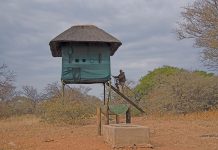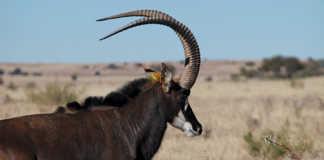
Photo: Courtesy of Dr Bentley Kaplan
A recent trial using prisms to curb baboons from entering Simon’s Town did not produce positive results.
The experiment was carried out by Drs Bentley Kaplan and Justin O’Riain of the Department of Biological Sciences at University of Cape Town and was prompted by anecdotal reports suggesting that chacma baboons in the Cederberg in the Western Cape were successfully prevented from raiding crops by rotating prisms similar to those used to deter birds.
Although the trial was conducted in an urban setting, the results are relevant to farmers who are under pressure to adopt ‘wildlife-friendly’ methods in animal-human conflict situations.
In some smallstock farming regions, baboons are reportedly catching up with black-backed jackals as the major predator.
The prisms were 19cm x 17cm x 16cm and made from fiberglass. Each was covered on three sides with mirrors, one of which was coated in red plastic.
They were mounted on poles 2,25m high and fitted to rotating motors powered by solar panels.
As the prisms turned, they reflected sunlight, with every third flash appearing red due to the red panel. Each cost about R2 500.
Four prisms were placed 300m apart in a line between a troop’s sleeping site (on a cliff-face) and their favourite raiding spots in town. They were positioned to reflect light directly at the sleeping site.
To get into Simon’s Town, the troop would have to either walk directly past the prisms or take a long detour, which would be out of character for the primates.
“We predicted that this set-up would limit the troop’s entry to town and decrease its access to high-caloric, human-derived food, therefore forcing the animals to spend more time foraging and less time resting or grooming,” says Kaplan.
However, the chacma is an intelligent, persistent, agile and social species with an uncanny knack for exploiting human-modified environments. Contrary to expectations, the troop showed no reduction in their use of residential Simon’s Town as a source of food.
In fact, they ignored the prisms, probably because of their daily exposure to a range of visual stimuli, including reflective windows, mirrors and bright lights.
In addition, the prisms had a negative effect on the presence of two non-target species, namely the hyrax (dassie) and red-winged starling.
Science or quackery?
“Our trial showed that reflective prisms were ineffective baboon deterrents,” says Kaplan. “Importantly, we now advocate the use of similar before- and after-trials for any deterrents that are being considered for widespread application. Ultimately, deciding which tools will reduce human-wildlife conflict is only possible when we know how effective – or indeed ineffective – each tool is.”
This point is put forward even more forcefully by John Shivik of the US Department of Agriculture’s Wildlife Services, at the National Wildlife Research Centre and Utah State University.
“As the knowledge on non-lethal techniques grows, there is a need to categorise and understand the plethora of methods that are being advertised by both scientists and charlatans. Many methods that are applicable in small pasture situations, for instance, may have little or no use in large, open-range situations,” he says.
More work required
Shivik stresses that the future of development and application of management techniques depends on sound science in a complex social and political environment.
“Efforts must be made to understand and limit habituation, to produce non-lethal techniques that work at the landscape and population scale, and to devise methods with maximal effectiveness but minimal cost and complexity. Producers should be educated about techniques that work and which of them are merely a waste of time and money,” he says.
Email Dr Bentley Kaplan at [email protected].
Source: ‘Shedding light on reflective prisms as potential baboon deterrents in the Cape Peninsula’, African Journal of Wildlife Research 45(1).













